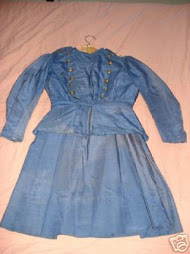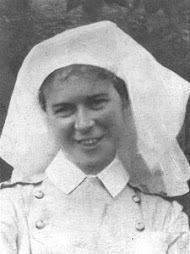Recently, I received an email from Glyn Hethey. She wrote: "my Great Aunt, Miriam Baker was a nursing sister and was killed at an early age in the war. Her picture is in the poster which hangs at the Memorial Centre here in High River[Alberta], and after moving here six yrs ago from BC, I was astounded to see her picture, the likeness of which hung in my Mother's house for as long as I can remember."
Glyn didn't know a lot about her great aunt, but her email raised my interest. I discovered a photo of Miriam on-line and realized that she must have served, not only in the CAMC, but in the British service. As I've mentioned before, so many of our Canadian nurses entered the QAIMNS initially, since so few places were open in the CAMC at the beginning of the war. Then they transferred over to the Canadian corps. I discovered that Miriam's files were intact at Britain's national archives, as well as in our own. But before I share what I learned from these files, I will add another quote, this time from Glyn's cousin, Allan Baker. Allan had a little more knowledge of Miriam:
"Our aunt, Miriam Eastman Baker, was the second of seven children born in ten years to George William Baker [ed. note: Baker was a Winnipeg lawyer, member of Winnipeg City Council and Winnipeg Police Magistrate] and his wife, Jennie Eastman Baker. Jennie was from Maine. She died when my father was born. Their father married twice again. Miriam played an extraordinary role in the raising of her siblings. Perhaps it was inevitable that Miriam would become a Canadian Army Medical Corps Nursing Sister in WWI. She was based at Cliveden. Like Miriam, four of her brothers served overseas, in the Canadian Army and the Royal Flying Corps."
According to Miriam's Canadian attestation papers, she was born in Winnipeg, Manitoba on August 20, 1886. She graduated from the St. Luke's Hospital nursing program in New York in 1915. Miriam appears to have enlisted in the QAIMNS in September 1916. At that time, she was serving in a British military hospital in Chatham, England. Miriam transferred to the Canadian service on October 2, 1917 and was assigned to the Canadian Red Cross Military Hospital in Cliveden, Buckinghamshire. Allan Baker describes some of the background of that hospital:
"Nancy Langhorne, born in Virginia, married Waldorf Astor, 2nd Viscount Astor. Thus she was identified as The Right Honourable Viscountess Astor, but she was known, as a public-spirited citizen, as Nancy Astor. In 1919 she became the first woman elected to the British Parliament. The Astors had a country home, Cliveden, on the Thames, west of London. It served as a hospital in WWI (and again in WWII)."
Almost a year after she began her work at Cliveden, Miriam contracted the Spanish influenza. She died on October 17, 1918 and is buried at the Cliveden War Cemetery. I believe her will provides a real glimpse into what Miriam was like. It appears that she was engaged, leaving her fiance Charles Herbert Dore her diamond ring, cigarette case, and small silver frame with his photo in it. She was religious, leaving her brother Phipps her silver-framed picture of Paul along with a brass clock. She leaves her pearl and turquoise ring to her friend Francis Chaffey, and to her brother Henry her watch, gold locket and chain. To her brother Ralph, her framed picture of Paul and Peter and silver mug. She left her silver card case to another friend, Edwina Higginson. Her sister Doris received the remainder of her jewelry and other personal possessions, her interest in an estate, and all the money she had in the bank with the exception of $50, which she left to her brother Paul.
It is clear that many mourned the loss of Miriam and that she left behind a loving family.
Subscribe to:
Post Comments (Atom)






















No comments:
Post a Comment